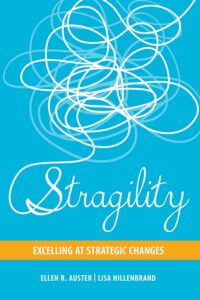Excel at Strategic Change
It’s more important than ever to be agile enough to respond to new trends, to change with speed, and to reinvent yourself or your organization.
How do you build a company that is capable of making these changes?
How do you make change stick?
What should leaders do to make strategy actionable?
Ellen R. Auster and Lisa Hillenbrand are the authors of STRAGILITY: Excelling at Strategic Changes. Ellen Auster is Professor of Strategic Management at York University. Lisa Hillenbrand is the founder of Lisa Hillenbrand & Associates. Their new book provides an actionable guide to helping strategy turn into successful execution. The authors have joined forces and have a new consulting firm called Stragility Change Management.
I recently asked them about their research and work in helping leaders excel at strategic change.
Master the 4 Stragility Skills
What is stragility?
Stragility is our word for Strategic, Agile, People Powered Change. It is the skills we all need to successfully lead organizational change. Tragically, 70% of changes fail — leaving companies and careers in ruin. Stragility skills can help all of us beat these odds. Whether you are a CEO, a midlevel manager, or front line supervisor, our book will help you lead successful change.
There are four critical Stragility Skills: sense and shift strategy, embrace the politics to build support for the change, inspire and engage the organization, and build change fitness to counter the change fatigue that is epidemic in our organizations today.
Skills to Excel at Strategic Changes
The title of Chapter 2 is intriguing “From Lock and Load to Sense and Shift.” Would you explain a little more about this shift in thinking?
Faced with relentless pressures, locking and loading on strategy is tempting but not a good idea. The world is always changing, and we need to stay ahead of the pack to succeed, or we’ll get blindsided. So sensing and shifting is about checking macro forces, keeping an eye on competitors’ moves, and watching those on the periphery on a regular basis. That way we can avoid, for example, what happened to Blackberry – once so dominant in cell phones, but so focused on competing incrementally that they totally missed the disruptive game-changing iPhone.
Doing regular internal check-ins to see what’s working well that can be amplified or re-applied and to identify what’s not working well that needs to be addressed is also key to continuing to evolve and staying out in front.
For example, Macy’s CEO Terry Lundgren has successfully steered Macy’s through a decade of growth by sensing and shifting strategies to delight customers. They’ve tailored offerings in each store, focused on developing employees’ selling skills, and become increasingly good at embracing new channels – like mobile and digital sales. We advocate that all organizations, big and small, sense and shift strategies to better serve customers and deliver their missions.
Embrace Politics
Politics is a negative word to most, but you say to embrace it. Why is this so critical to change management?
Ignoring politics or trying to push people forward when they’re resisting usually backfires and leads to more escalation not less. However, when we enroll people in the changes, understand their point of view, and address their concerns, then we not only can move forward, but we build commitment, passion and ownership. As a result, everyone offers their best ideas and helps to propel the change forward. Beyond the immediate change, this is also essential for creating receptivity to future changes.
In his first week as President of KFC, David Novak faced a national franchisee meeting full of angry franchisees. Business was soft and they were furious. In the face of this, Novak needed to marshal his political skills. Instead of getting defensive, he began the meeting by reminding everyone of their shared purpose and mission and then listened to concerns. Then, he divided the group into breakout sessions, each with the task of imagining they were President of KFC and coming up with an action plan. The groups returned with three proposals: improve quality, train people, and launch new menu items. And that’s what they did. And in the process they got back to growing. It is a great example of managing the politics and emotions of change.
Utilize Key Influencers
Talk a little about the importance of key influencers in driving change.
Key influencers are individuals who are the opinion leaders in the organization. These key influencers often have the resources, skills or social networks needed to win over the hearts and minds of the larger group. Influencers can also be very helpful in enabling their groups or teams to understand the pros and cons of change from the standpoint of different stakeholders, and in persuading others to support the change.
In addition to listening and engaging with those predisposed positively towards the change, we also need to work with key influencers who are more skeptical. Most leaders are inclined to pay attention to the supporters and ignore the skeptics. As tempting as it is to walk away from so-called skeptics, this is rarely the best approach.
In reality, many are what we’d call “positive skeptics.” That is, they believe that the change has flaws that need to be addressed. Engaging these skeptics has many benefits. They can be catalysts for rethinking different aspects of the change to make it more successful – which can save teams months of rework by catching flaws early. Second, involving them often leads to their increased ownership and commitment. Instead of standing on the sidelines, they often become change as the change rolls out. Finally, engaging them sends a powerful signal to the rest of the organization that all voices and opinions are important, alternative points of view can be heard, and constructive feedback on this and future efforts is welcome.
How can we enroll people to get passionate about the change?
People often have insufficient understanding of why they need to change. We all know that it is hard for us to commit to something if we don’t know why we’re supposed to do it. Yet in organizations — where we spend much of our lives — we often expect people to dive in with head and heart without understanding the rationale behind the changes they’re being asked to make.
At the core of every great strategic change are a compelling vision and business case, which create a persuasive rationale for why the company is headed in this new direction.
Mantras and stories can really help. For example, one accounting firm’s plan to solve their female retention issue was called the “War for Talent.” It moved the company away from seeing the retention issue as a women’s problem and instead linked it to their mission-critical goal of attracting top performers. And P&G CEO A.G. Lafley used the mantra “Consumer Is Boss” to underscore that every decision and every action should be evaluated with the consumer in mind.
These sound like great skills for C-Suite executives but how do they apply to smaller enterprises or individual teams?
Change is often harder for small businesses – you’re frequently competing against big, well-funded organizations, the environment is constantly shifting, yet you have little slack and tight budgets.
The good news is that Stragility skills work whether you are in a big or a small company and whether you’re the CEO, a midlevel manager, or a front line employee. One of our favorite stories in the book is about a change led by one person that has been embraced globally.
They say no man is an island – but in this story there really was a man leading an island! Soren Hermansen led a project to transform a Danish island into the first 100% renewable-energy powered island. His only “staff” was his wife, Malene. And he faced a high degree of skepticism that this was a hippy project with vague promises of a healthier planet that people couldn’t relate to.
His solution was coffee and beer diplomacy with opinion leaders in different groups, and figuring out how this change would benefit them. For example, farmers would have a new crop – elephant grass to provide biomass for the new power plants; plumbers would have new jobs servicing heat pumps; and homeowners would be assisted by government incentives. Hermansen’s home became the first 100% renewable island in the world, and he now teaches others how to do it!
We often forget to ask about what to stop doing. Why? And why is it so much harder to stop something than to start it?
That’s so true, Skip. Every project has some merit. If we don’t weed frequently, we find that there are so many worthy projects competing for resources choking each other like weeds in a garden. When Steve Jobs returned to Apple he famously narrowed the priorities to just two big projects – one became the iPhone and the other the Mac. If Apple can concentrate so narrowly, we all can find ways to sunset projects and provide greater focus.
Tell us more about “change fitness” and why it’s the most important of the 4 stragility skills?
 We would say that having all 4 skills is critical, but certainly if you or your organization is burnt out, change is nearly impossible. So yes, change fitness is the critical foundational skill.
We would say that having all 4 skills is critical, but certainly if you or your organization is burnt out, change is nearly impossible. So yes, change fitness is the critical foundational skill.
Change is exhausting, and change fatigue is epidemic in organizations today. Most of us are juggling multiple projects and change efforts under pressing deadlines, and are frequently overwhelmed. Top performing change leaders succeed by changing less to achieve more. To avoid change fatigue, we need to ruthlessly eliminate less critical projects to leave time for those that are truly mission-critical – recall the Steve Jobs story. We can also pilot programs on a smaller scale before rolling out at full scale to avoid rework and identify glitches early. Institutionalizing after-action reviews is also beneficial for it allows us to reapply what works and avoid repeating the same mistakes over and over.
What’s the greatest challenge leaders face today?
We believe leaders’ greatest challenge lies in formulating winning strategies and getting them executed. So much of strategic change fails – 70% of changes are unsuccessful, leaving companies weaker and employees burnt out. The good news is that Stragility change skills can be learned and can become a company’s greatest competitive advantage. They enable our organizations not only to win at their current change challenges but to simultaneously build and strengthen their stragility skills for tomorrow’s strategic shifts.
 Beyond reading your book, STRAGILITY: Excelling at Strategic Changes, what else can leaders do to get started?
Beyond reading your book, STRAGILITY: Excelling at Strategic Changes, what else can leaders do to get started?
We’ve included diagnostic tools and guidance to aid application of our strategies. We also encourage you to contact us at StragilityChangeManagement.com. We have change workshops, keynotes and one-on-one consulting options we’ll customize for any organization.
STRAGILITY: Excelling at Strategic Changes


